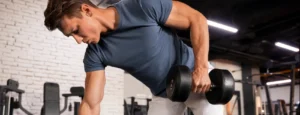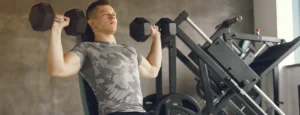Hammer curls are a popular exercise that target the muscles of the upper arm, primarily the biceps brachii. They are named after the motion of a hammer striking, as the grip resembles holding a hammer. Here’s a description of hammer curls, including the muscle groups worked.
During a hammer curl, you hold a dumbbell in each hand with a neutral grip, palms facing inward towards each other. Starting with your arms fully extended by your sides, you flex your elbows, lifting the dumbbells towards your shoulders while maintaining a stable and controlled motion.
The primary muscle worked during hammer curls is the biceps brachii, which is located on the front of the upper arm. The biceps brachii is responsible for elbow flexion and forearm supination. By performing hammer curls, you engage and strengthen the biceps, helping to increase their size, strength, and definition.
In addition to the biceps, hammer curls also target the brachialis muscle, which lies underneath the biceps. The brachialis is an important muscle for arm strength as it contributes to elbow flexion. By targeting the brachialis through hammer curls, you can enhance the overall development of the upper arm.
Hammer curls also engage the muscles of the forearm, particularly the brachioradialis. The brachioradialis is a muscle located on the thumb side of the forearm and plays a significant role in elbow flexion. By performing hammer curls, you can strengthen and develop the brachioradialis, improving forearm strength and stability.
Furthermore, hammer curls engage the stabilizing muscles of the upper arm and shoulder girdle. The muscles of the upper back, such as the rear deltoids, rhomboids, and trapezius, work to stabilize the shoulder joint during the movement. This provides additional benefits for postural strength and stability.
One advantage of hammer curls is their ability to target different areas of the biceps compared to other curl variations. While traditional bicep curls primarily emphasize the short head of the biceps, hammer curls place greater emphasis on the long head of the biceps. This variation helps create a more balanced and well-rounded development of the biceps muscles.
Incorporating hammer curls into your fitblendr blend can help you develop stronger, more defined arms. It’s important to maintain proper form throughout the exercise, keeping your core engaged, shoulders stabilized, and performing controlled movements. Start with lighter weights and gradually increase the resistance as your strength improves to ensure safe and effective progression.
Hammer Curls – Instructions & Steps
- Hold the dumbbells at your sides
- Lift them at the same time, bending your arm at the elbows and beginning to twist your wrists outwards so your palms start to face you
- Once at the top of the motion, your hands will resemle a position you might hold a hammer in
- Slowly lower your arms and rotate your wrists back so the dumbbells are at your sides again
Benefits of Hammer Curls
Hammer curls offer several benefits for those looking to strengthen and develop their arms. It’s important to perform hammer curls with proper form, keeping your core engaged, shoulders stabilized, and maintaining controlled movements. Start with lighter weights and gradually increase the resistance as your strength improves to ensure safe and effective progression. Here are some key advantages of incorporating hammer curls into your workout routine.
Bicep Development
Hammer curls target the biceps brachii muscles, which are responsible for flexing the elbow joint and lifting objects towards the shoulders. By performing hammer curls, you specifically target the long head of the biceps, helping to increase muscle size, strength, and definition in this area.
Balanced Arm Development
Traditional bicep curls primarily target the short head of the biceps. Hammer curls, on the other hand, emphasize the long head of the biceps to a greater extent. By incorporating hammer curls into your routine, you can achieve a more balanced development of the biceps, promoting symmetry and proportion in your arm muscles.
Forearm Strength
Hammer curls engage the muscles of the forearm, particularly the brachioradialis. This muscle is responsible for forearm flexion and plays a significant role in activities such as gripping and lifting. By strengthening the brachioradialis through hammer curls, you can improve forearm strength and stability, which can be beneficial in various sports and daily activities.
Grip Strength
The gripping action required during hammer curls helps to develop grip strength. As you hold the dumbbells with a neutral grip, your forearm muscles, including the flexors and extensors, are engaged to stabilize the weight. Strengthening your grip can have practical applications in activities that require holding onto objects, such as weightlifting, rock climbing, or even everyday tasks like carrying groceries.
Stabilizer Muscles
Hammer curls also engage the stabilizer muscles of the upper arm and shoulder girdle, including the muscles of the upper back such as the rear deltoids, rhomboids, and trapezius. These muscles work to stabilize the shoulder joint and maintain proper posture during the exercise. Strengthening these stabilizer muscles can enhance overall shoulder stability and contribute to better posture.
Versatility
Hammer curls can be performed with a variety of equipment, including dumbbells, kettlebells, or resistance bands. This versatility allows you to adjust the resistance and intensity according to your fitness level and equipment availability.
Variation and Muscle Confusion
Adding hammer curls to your arm training routine provides variation and helps prevent muscle adaptation. By incorporating different exercises like hammer curls alongside traditional bicep curls, you challenge your muscles in new ways, promoting continuous muscle growth and development.
More About Hammer Curls
Hammer curls are not considered compound exercises. They are an isolation exercise that primarily targets the brachialis and brachioradialis muscles in the forearm, as well as the biceps to some extent. Hammer curls are typically performed by lifting weights, such as dumbbells, with your palms facing inwards (neutral grip).
During hammer curls, the following muscle groups are engaged:
- Brachialis: A muscle located underneath the biceps, which is responsible for elbow flexion.
- Brachioradialis: A muscle on the forearm that assists in elbow flexion.
- Biceps brachii: The two-headed muscle on the front of the upper arm is involved to some degree as a secondary muscle.
Hammer curls are effective for targeting the muscles in the forearms, particularly the brachialis and brachioradialis. Additionally, they provide a secondary workout for the biceps. However, since hammer curls primarily involve movement at the elbow joint and mainly focus on specific muscle groups, they are not classified as compound exercises.
To engage in compound movements that work multiple muscle groups simultaneously, exercises such as pull-ups, rows, deadlifts, and chin-ups are more appropriate choices.




